In our screen-dominated age, how do you start selling something you can’t easily photograph or show on a web page? Digital embellishment is an enormously effective way of boosting the visual and tactile power of print, but how can printers and service providers win over customers who’ve never seen or touched it before?
The obvious answer is to get samples in their hands and under their noses. We talk to three U.S. print service providers that have successfully won over customers after installing digital embellishment production systems. They’ve used hard work and clever marketing to educate their customers, and sometimes their customers’ customers, or their customers’ designers, about the added impact that embellishment can give their messaging.
Jeff Alexander, CEO Alexander’s
 First up is Alexander’s, a private, family-owned and operated company based 30 miles south of Salt Lake City, Utah. Jeff Alexander founded the company in 1979 and has grown it from a multiple-location copy shop to a global print and fulfillment enterprise.
First up is Alexander’s, a private, family-owned and operated company based 30 miles south of Salt Lake City, Utah. Jeff Alexander founded the company in 1979 and has grown it from a multiple-location copy shop to a global print and fulfillment enterprise.
With over 240 employees, Alexander’s now serves clients in 14 countries and ships to over 30 countries. It specializes in custom print-on-demand products through technology-based solutions. It has HP Indigo liquid toner presses and for digital embellishment, it runs both Scodix and MGI inkjet embellishment systems, both equipped with foiling options.
Alexander outlines his company’s development path.
“We started out as a retail copy center, and then in the mid-1990s, we began to really evolve into more commercial print. By the beginning of the 2000s, we were focused a lot on technology and we’ve had our own tech team for over 20 years, until today we’re deep into commercial print.”
A lot of work now comes in from other providers that hook into Alexander’s API for direct web-to-print ordering. Alexander’s prints and fulfills these.
“We embellish a lot of books. We do a lot of greeting cards and envelopes. Just a variety of different products, but the books especially are one-off, and that’s become a specialty for us. We use a lot of digital embellishment, which has become a major part of what we now offer our customers.”
Initially, he was skeptical about digital embellishment.
“About six months before we decided to buy our first press, somebody came by trying to sell it to us and we flat out said no, we just weren’t interested. Then we went to one of the print shows, and I had a greater chance to look and really get a feel for it. I just had this, really a gut feeling, that something could happen here. And that’s when we first met MGI. We talked it through quite a bit and felt that we could create a market.”
Once Alexander’s decided to create that market, it went full steam for it, and its methods could be a lesson for anyone considering adopting digital embellishment.
“At that time we weren’t doing a lot online, we were just beginning that process,” Alexander said. “So we worked in a significant way with local designers, teaching them how to design, to use digital varnish and foil. It took us a while to get their attention.
“We had a lot of open houses. We were out there meeting with anybody we could and making a lot of our own samples so that they could get a feel for what it was. We would bring people in and ask them to send us files ahead of time so that we could prep them and show them how it could work. It took us six to nine months to develop a solid business in that area.”
Samples played a big part in this strategy.
“We couldn’t have done it without samples. You could talk about it all day long, but once they see it and they understand what it could do to their design, that made it. Then you couldn’t change their minds. If we could get this in somebody’s hand, they wouldn’t set it down. We even branded a name for ourselves called Tektured.”
Alexander said the challenge was slightly different for customers who were already aware of traditional embellishment.
“They’d say, ‘I’d rather have traditional foil; it looks much nicer.’ But once we could get digital in their hands, they saw how crisp and nice it was, and they began to realize, whoa, you can do customized work! So if it’s an invitation going to people for, say, an open house, you could personalize it for each person receiving the invitation in foil. It was just a hit; it made a huge difference to people. But they had to be able to feel it.”
What does Alexander’s find are hot spots for personalization?
“We’ll customize invitations, greeting cards, book covers,” Alexander said. “We’re even experimenting with whether you could add foil to a photo book all the way through. We’ve done a lot of boxes, and they are a real hit for people.
“For instance, at one of the local universities, we work closely with their athletics department, sometimes for recruiting, other times it might be fundraising or tickets for sports events. They’ll personalize a box, fill it with some gear and send it out. And we use the foil on that a lot so that it stands out, totally personalized to that person that it’s going to.”
If he had to choose between digital embossing and foiling, Alexander says it would be foiling, though pointing out that his Scodix and MGI systems can do both.
“I’d still go with the foil because it stands out. But I’d also love the opportunity to add some varnish on top of that foil to finish it off. It’s just gorgeous!”
(Watch Kevin Abergel’s video interview with Jeff Alexander here.)
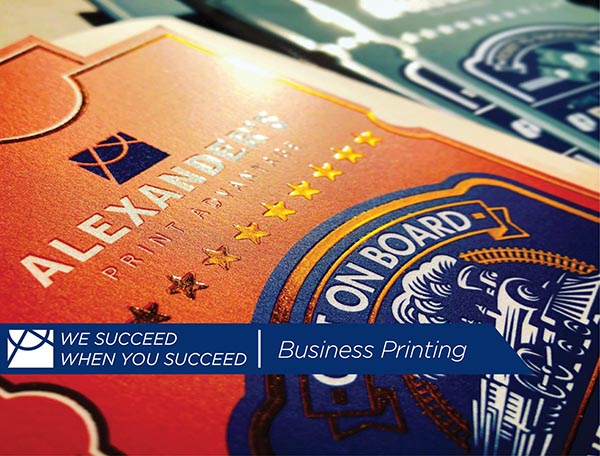
The magic of Alexanders’ dimensional varnish is on top of metallic effects in this stunning self-promo piece on display.
David Baird, President, Truly Engaging
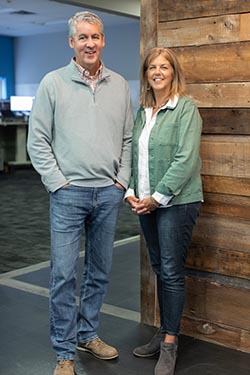 Next on our list of digital embellishment success stories is Truly Engaging of Arden Mills, Minn. This online, full-service stationery store offers B2C and B2B personalized products with unique messages. It designs and produces magnets, cards and other stationery.
Next on our list of digital embellishment success stories is Truly Engaging of Arden Mills, Minn. This online, full-service stationery store offers B2C and B2B personalized products with unique messages. It designs and produces magnets, cards and other stationery.
The company, founded in 1991, was originally called Magnet Street, and is currently run by President David Baird. When it grew large enough to bring print inhouse, it was digital from the start—today’s presses include an HP Indigo 12000 and a Xerox iGen4 Diamond Edition.
Initially the property market was booming.
“We started by making schedule magnets and all kinds of longer run magnets," Baird said. "Then we figured out how to do real short-run magnets. We sold direct before there was a thing called the internet.
“All of a sudden we could do short runs and all these things, and then the internet came along. We hired an SEO specialist, which seems funny because we didn’t even know what SEO was. But he came to me on a Friday and said, ‘Hey, what’s a save-the-date?’ I said, ‘You got me. I have no idea.’ He goes, ‘Well, there’s tons of people searching on the web for this thing called save-the-date magnets.’ And I’m like, ‘Wow, that’s cool. I have no idea what that is.’ He goes, ‘Yeah, it’s for weddings.’
“So I went home and stopped at a Walgreens on my way. I picked up three bride magazines and I spent the weekend scouring them. My family thought, ‘Oh gosh, dad has lost his marbles.' But then I saw ads for wedding planners and all those kind of things, and it was just crazy. So within four, five, six months, we launched Magnet Street Wedding. And it absolutely exploded. We did, I think 70,000 weddings our first year.
“We started a blog a few years later called 'Truly Engaging' and we went from save-the-date magnets to invitations and programs, the whole wedding print suite.”
Baird said embellishment was a natural add-on.
“We were looking to constantly improve on the process. What else can make it interesting? We started seeing some of this digital embellishment, specifically foil.
“And we’re like, ‘Brides like foil, right?’ They like it on all kinds of things. So we kind of faked it. We were doing a poor man’s sleeking just to prove that there’s an appetite for it and they’re willing to pay for it, and it can set us apart.
"As demand took off, however, foil-laminators were too slow, so the question was how to scale up. After much research, the answer was a Scodix digital inkjet.”
How did Truly Engaging market this, given the limitations of on-screen previewing for embellishment? As with Alexander’s, he put samples in the hands of potential customers.
“On the wedding side, we’re sending out literally tens of thousands of samples a month. What set Truly Engaging apart, initially, was you can order one. You give your details and a few days later you get it in the mail, so you get to hold it in your hand.
“For us that’s the big challenge. We’re a web, online, e-commerce company. We need to get brides to trust us. So we did a ton of sampling, and then word of mouth really took it from there. If we send a bride a sample with no foil on it, and then with foil on it, we win. Once you see it and feel it with foil, it’s like you can’t look away.”
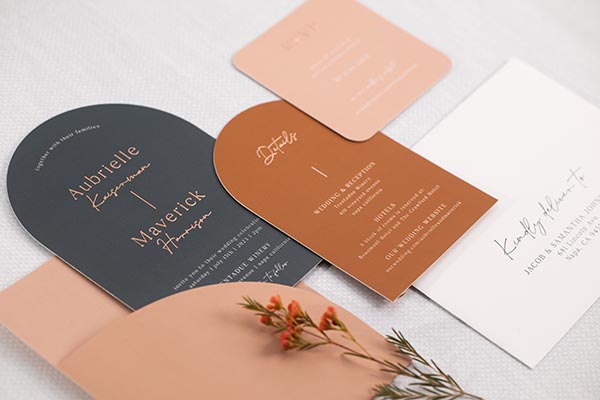
Truly Engaging’s elegant use of digitally raised copper foil—adding a touch of sophistication to his client’s special day.
The same idea was applied to the company’s other main vertical markets, especially colleges.
“In our college market, we’ll send one of each and say we’re not going to decide, you decide. Well, 99 times out of 100 if the budget’s there, then foil wins, varnish wins. So sampling for us has been really, really big.”
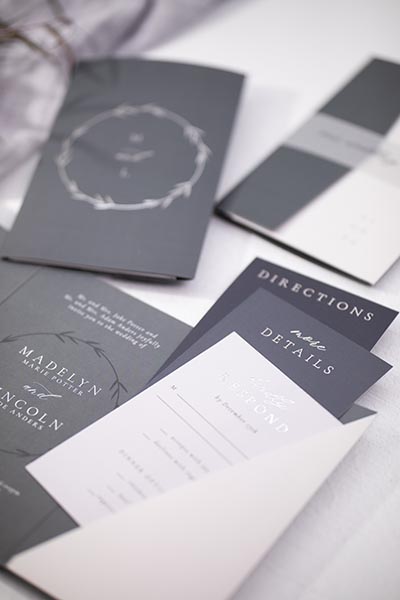
Elevating wedding invitations, Truly Engaging’s custom embellished invitations create bespoke designs that are as beautiful as they are unique.
Once the Scodix was in, new ideas started to come through for applications. Labels was one. Although uncertain whether the Scodix varnish would work with label material, they did a trial on a real label job for a university mailer.
“So we quickly set up the masking file and varnish and it was awesome,” Baird said. “I think we hardly sell a sticker any more without varnish. It just makes it pop, it’s amazing. Whether we’re doing magnets or we’re doing stickers for universities, we’re varnishing it at least eight times out of 10 now.”
When hypothetically asked to choose between keeping digital varnish or foil, Baird said it depends on the market.
“Foil for sure in our wedding market. Our consumer market is foil, no question. But for sports, universities and commercial, all-foil would be too expensive. We can put a nice, clear varnish on their logos and it’s awesome. We have gone away from foil in those markets, with much more use of varnish.”
(Watch Kevin Abergel’s video interview with Dave Baird here.)
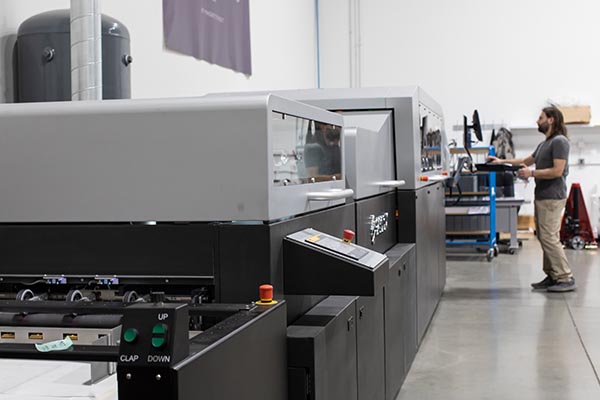
Behold the power of Truly Engaging’s Scodix digital enhancement press.
Tony Rouse, CEO at Team Concept
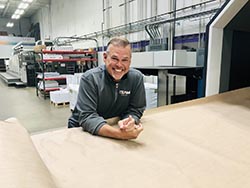 Our final success story comes from Team Concept Printing, based in Carol Stream, Ill. It is primarily a trade printer offering services to other printers, but also works with agencies, designers and print brokers. It has both litho and digital presses, a range of finishing and binding equipment and mailing facilities. Standard products include stationery and greeting cards, mailers, booklets, boxes and packaging, signs and banners, folders and card holders.
Our final success story comes from Team Concept Printing, based in Carol Stream, Ill. It is primarily a trade printer offering services to other printers, but also works with agencies, designers and print brokers. It has both litho and digital presses, a range of finishing and binding equipment and mailing facilities. Standard products include stationery and greeting cards, mailers, booklets, boxes and packaging, signs and banners, folders and card holders.
Team Concept’s current embellishment arsenal includes thermography, traditional embossing and debossing, digital spot UV varnish with digital embossing, laminated foil (“Sleeking”), and book edge decoration.
In 2018, the company installed an MGI JetVarnish 3D digital UV varnishing inkjet with raised imaging and iFoil foiling unit. It uses a brand name, LuxFX, to cover these.
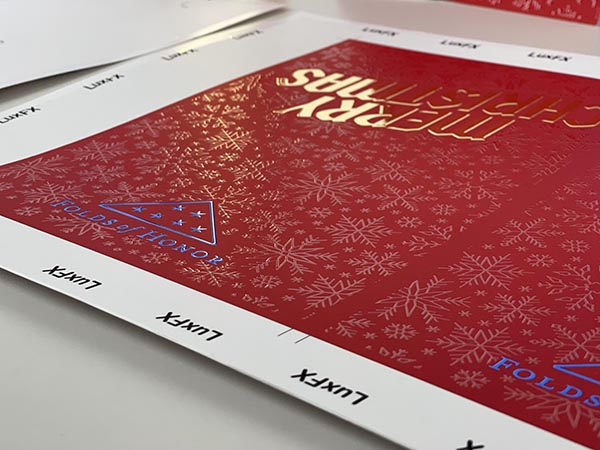
Exquisite LuxFX piece by Team Concept Printing—featuring softouch lamination, digitally produced dimensional varnish, and stunning embossed gold and blue foil accents.
We spoke to owner Tony Rouse, who is also the Founder and CEO. He founded Team in 1998 after a career in print. Digital embellishment was a natural progression from physical stamping.
“We’ve always done hot foil stamping and embossing,” he said. “We did it on a Kluge. We started in ’98 and I think we got our first Kluge in maybe 2000.
“We could see the market changing from people sending in RFQs. If we’re not able to do them or we see something different, we start making a little note. Our estimators make a note and say, ‘OK, we’ve been asked this 12 times in the last six months and it’s not something we could do.’ Then we have a team that looks and says, ‘OK, this is something we need to learn about.’”
As digital embellishment appeared, requests started to change.
“Those embellishment RFQs, they were different than the Kluge foil stamping and embossing we were doing,” Rouse said.
Expanding embellishment was a logical response to customer needs.
“Everything that we do here has been answering the bell with what the client has needed, to drive more print,” he said. "So embellishment was a natural thing because it opened the door to us for some clients who were looking for that one need. And even if it was only a tiny percentage of the work they sent us, it still was something we didn’t want someone else doing. So we said we need to be able to step up and answer that.”
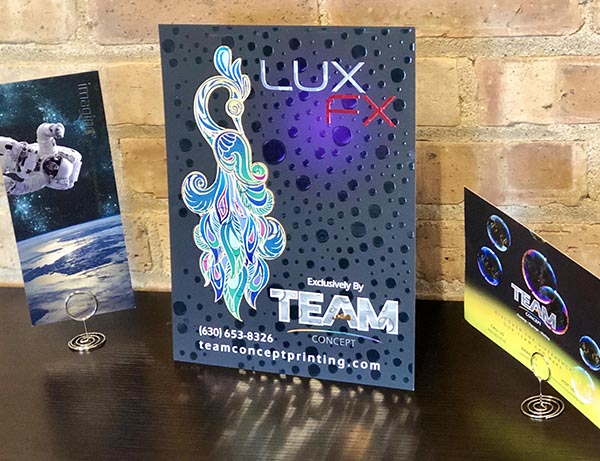
Team Concept’s LuxFX embellishment brand in action with this eye-catching self-promo piece is sure to leave a lasting impression.
Team Concept Printing had to take a different approach to promote digital embellishment once it got it in.
“Market education has been huge because the biggest thing is since we’re predominantly a trade printer, we rely on being able to tell our clients who are in the middle a lot of times, to be able to then go to their end user and say, 'Hey this is something new that you want to consider.'
“You need to get it out, so the end user person sees it and goes, ‘Yes, that’s something I want on my marketing piece or my mailer to make it different from everything else.’
“So, we’ve done a great job on our social media. Trying to showcase it, have people share it. There’s a lot of times we do that and people will message us off of that and say, 'Hey, we want to take a look at that for our project.'”
Part of this work was in giving digital embellishment a brand name.
“You need to make it so that you’re different than everyone else. Come up with a name for that.
“And so we came up with LUXfx. We even use it for thermography now, where that used to be our standard. Now for anything we add onto a piece to decorate it differently, maybe glitter, thermography, or we even put scented inks or different things like that, we include that under our LUXfx umbrella.”
So, foil or varnish, if he had to keep just one?
“The dimensional varnish. While I love the foil and we use it all the time, I think the things you can do with the dimensional varnish really make a piece sparkle, and there’s no other way to do that. We have ways we would still be able to have a really nice foil product, but there’s nothing like the dimensional varnish to be able to really make something stand out.”
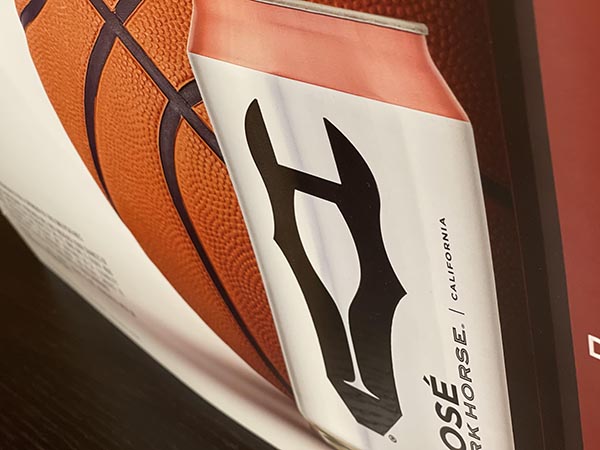
Using the texture of a basketball as inspiration, Team Concept showcases their impressive LuxFX tactile embellishment capabilities in this captivating piece.















Discussion
By Robert Godwin on Jun 09, 2023
Kevin,
The use of the word "creating" in the article title is misleading. Printers manufacture. Art directors, copy writers and designers create. Most of the embellishment ordered in the market are effects that have existed for a long, long time.
The tactile experience is not new. It is the technology to produce them in manufacturing process that has made them easier to produce and more cost effective to use in a product.
By Kevin Abergel on Jun 09, 2023
Robert, thank you for taking the time to share your insightful comments on the article. You've provided an interesting perspective that encourages us to consider the nuances within the creative process.
I completely agree with your distinction between the roles of printers, art directors, copywriters, and designers. Indeed, they each contribute uniquely to the final product, and the term "creating" may seem to oversimplify this multifaceted process. Nevertheless, I used it in a broader sense, indicating not only the ideation phase but also the final execution. The synthesis of concept and physical realization often results in the tactile experiences that we come to cherish.
Moreover, you're absolutely right in saying that the tactile experience is not a new concept. Its roots stretch back to our earliest interactions with the world, which were predominantly tactile. However, the focus of the article was to highlight how recent technological advancements have allowed us to incorporate tactile experiences in new, more accessible, and cost-effective ways. These advancements have opened up fresh avenues for creativity and unique user experiences, even if the embellishments themselves are not new.
Your comments underline the importance of recognizing the contributions of all parties involved and the role of technological progress in our ability to deliver tactile experiences. I hope future articles continue to pique your interest and spark such engaging discussions.
Thank you again for your thoughtful input.
By Robert Godwin on Jun 09, 2023
In the Jeff Alexander section the topic of creating a market is the most critical issue. Perhaps that topic becomes the next phase of the 'tactile' experience. Addressing the market and forming a compelling message to the brand managers and their creative teams is what printers should prioritize. Inspiring a need leads to sales.
By Warren Werbitt on Jun 09, 2023
Robert Goodwin When did you become a word smith? They are creating an experience for their clients. Who's to say anything different? Why even comment, when they they are moving the ball forward doing great things in the industry. Robert, I'm not looking to start, but you don't have to be so down on the industry. ??
By Robert Godwin on Jun 09, 2023
Warren,
First off, not down on the industry, simply realistic from a business persepctive. I disdain the influencer cheerleading that masks as marketing.
Second, the issue is focus. Efforts to add value by calling a manufacturing process creative is misguided.
Third, developing a marketing/sales program that informs the creatives about what is possible is a more effective means to driving more business into an operation.
Look at Will Crabtree's offerings from his businesses in Tampa. He has done an excellent job segmenting value services to his market and is an exemplar of smart business practice.
By Joanne Gore on Jun 12, 2023
Influencer cheerleading! What an AWESOME term! Marketing has changed - and influencers hold the cards. So why the disdain, Robert? I believe the more print cheerleaders we have - the stronger our industry brand becomes.